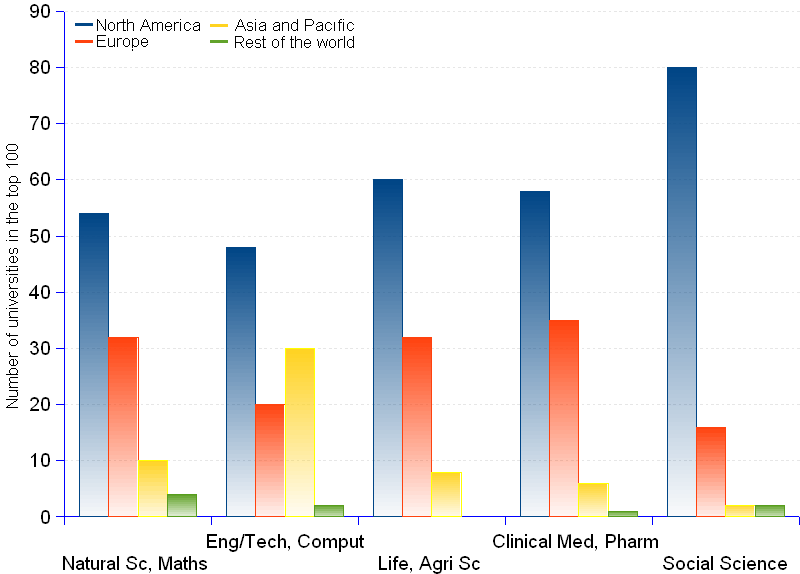

When it comes to assess who is good at what, the ordinary man's perception is probably in synch with the worldview provided by the regional distribution of world elite universities by scientific field. Surely things remain stable at the generic level, with North America still having 61% and Europe 27% of the world top 100 universities in all 5 scientific fields appearing in the chart. Western supremacy is unquestionable. However, if you take North America, some subtle sliding betrays the shifting focus of interest in North American academia. Engineering, technology and computer science, a field that was already the poor parent in terms of number of elite schools, lost another couple of slots in favor of Asia Pacific. As everyone knows, if one thinks of cars, computers or mobile phones, the immediate association is Asia — Japan, China, Taiwan. This is where the development and manufacturing capabilities are, albeit the branding and the distribution are often an American thing.
Life and agriculture sciences and clinical medicine and pharmacy also lost slots in North America. Only the number of top universities in natural sciences and mathematics remain unaltered, and social science, which had already the most universities in the ranking, made further progress, accounting for 80% of the world top 100 institutions in the field.
Europe remained at a quasi standstill, the only changes registered being the addition of one university in clinical medicine and pharmacy, and the loss of one slot in social science. In engineering, technology and computer science, Europe is losing ground, counting only 20 universities in the ranking, well behind Asia Pacific and North America. This is another element of the explanation why the much heralded 2000 Lisbon strategy aimed at making the European Union "the most competitive and dynamic knowledge-based economy in the world capable of sustainable economic growth with more and better jobs and greater social cohesion" by 2010 misfired so pitifully.
Asia Pacific keeps progressing, placing 56 universities in the ranking, or 3 more than in 2011. As one would expect, the gains took place in engineering, technology and computer science (2 more slots) and in life and agriculture sciences (1 more slot). Such a strong presence might correlate to the growing weight commanded by the region in the world's economic, financial, commercial, military and political affairs.
Academic ranking of world universities by scientific field and by region in 2012 | |||||
Scientific Field | North America | Europe | Asia & Pacific | Rest of the World | Total |
| Natural Sciences and Mathematics | 54 | 32 | 10 | 4 | 100 |
| Engineering/Technology and Computer Sciences | 48 | 20 | 30 | 2 | 100 |
| Life and Agriculture Sciences | 60 | 32 | 8 | 0 | 100 |
| Clinical Medicine and Pharmacy | 58 | 35 | 6 | 1 | 100 |
| Social Science | 80 | 16 | 2 | 2 | 100 |
| Total (number) | 300 | 135 | 56 | 9 | 500 |
| Total (percent) | 60% | 27% | 11% | 2% | 100% |
Sources: Institute of Higher Education, Shanghai.